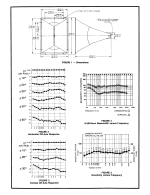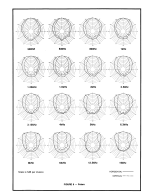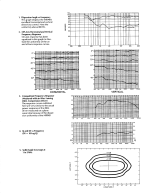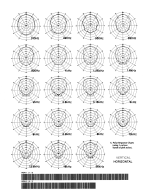I use Lyngdorf 1120, and it is the most pleasant-sounding D-class amplifier I have ever had (tried n-core, icepower, NAD DDFA, Tripath ta2024). But with DSP on Lyngdorfs board I get such a comfortable system to DIY (especially convenient to have separate outputs with EQ and delays for subwoofers - I tuned my bass better than ever) that you just don't want to look at anything else. And the sound quality is excellent.With active crossover on the sub and some suttle eq on the horns the amp discussion seems to dissappear and the convenience of class-d takes over.
By the way, ta2024 also sounds great for pennies, if 10-15 watts suit you. Thats how I went back from the tubes to the d-class. I listened SE tube amp for a long time, rolled the tubes, I liked the sound - it was fun. But one day I picked up a $20 ta2024 board, plugged it in... and the next day the tube went on sale 🙂
I find it a bit ugly bot it might be a good candidate to use with one of the B&C coax drivers if someone doesn't need or want the size and low end extension of the ME464.
Regards
Charles
It's not the prettiest horn out there, that's right.
I'm still considering laminating one (after removal of the vanes) from the inside with sheets of (Japanese) wood paper and epoxy raisin or wood glue. Adding layers until the throat is 1".
There's the option to laminate around the mouth edge, increasing the roundover and mouth circumference.
And just for the record. I tried filling it with foam. I didn't save the measurements, from memory, all I found was a slight drop in high frequencies, about 3 dB. I found no benefit to the ear and removed the foam.(after removal of the vanes)
Also, I have tried paper-mâché membrane coating. This seems to be promising, according to the measurements, the peak at 15 kilohertz was gone and the sound was a little smoother. But the problem is that I was unable to achieve the same frequency response between the two drivers, and I do not have a per-channel equalizer, so I'm removed paper (It's nice that it just rinses off with water). I need to buy a couple of membranes (just in case something goes wrong, don't want left without music) and return to this idea.
And now I use drivers without a back cover with a felt plug in the hope of getting a little cardioid in the lower border. I'm a little crazy, yeah 😗 But I need a free weekend to take measurements, does that make sense. Sounds ok.
Hope this isn't too off-topic.
Last edited:
The TAD should be better for about 20x the price. The ND350 is one of the best 1" low budget drivers, but I'd not use it below 1500Hz, or perhaps 1200Hz with a proper horn.I have tried an rcf nd350 vs tad 2002, granted the horn was not right for either driver but it was apples and oranges already under these unfavorable conditions.
Damn, I forgot, I tried papier-mâché, and after that I tried toothpaste membrane coating 🙂 it's easier to apply, after drying it gives a fairly hard and light coating, and it worked better than paper by measurements (which I don't save, bad habit). But I still didn’t get the same FR there were slight discrepancies in the treble, which may not be as audible as theoretically annoying.. Now the membranes are again uncoated.
You might try to stick (using double-sided tape) a small piece of 30ppi foam in the center of the rear cover, just thick enough to touch the top of the diaphragm.And just for the record. I tried filling it with foam. I didn't save the measurements, from memory, all I found was a slight drop in high frequencies, about 3 dB. I found no benefit to the ear and removed the foam.
Also, I have tried paper-mâché membrane coating. This seems to be promising, according to the measurements, the peak at 15 kilohertz was gone and the sound was a little smoother. But the problem is that I was unable to achieve the same frequency response between the two drivers, and I do not have a per-channel equalizer, so I'm removed paper (It's nice that it just rinses off with water). I need to buy a couple of membranes (just in case something goes wrong, don't want left without music) and return to this idea.
And now I use drivers without a back cover with a felt plug in the hope of getting a little cardioid in the lower border. I'm a little crazy, yeah 😗 But I need a free weekend to take measurements, does that make sense. Sounds ok.
Hope this isn't too off-topic.
View attachment 1177819View attachment 1177817
Maybe this is the only mod I haven't tried 🙂You might try to glue a small piece of 30ppi foamin the center of the rear cover, just thick enough to touch the top of the diaphragm.
Right now I'm using a driver with the cover removed, with multiple layers of thick felt on the back. It seemed to me that this had a positive effect on the upper frequencies (again, I did not save the measurements, one day I will get and document this normally).
One possible test that promises to have more controllable effects between the two drives is the application of a flocking layer on the rear surface of the dome. Unfortunately, it is not removable. There is a paper on the acoustic properties of flocking but I cannot download it. I have asked the author to send it to me but so far without success.And just for the record. I tried filling it with foam. I didn't save the measurements, from memory, all I found was a slight drop in high frequencies, about 3 dB. I found no benefit to the ear and removed the foam.
Also, I have tried paper-mâché membrane coating. This seems to be promising, according to the measurements, the peak at 15 kilohertz was gone and the sound was a little smoother. But the problem is that I was unable to achieve the same frequency response between the two drivers, and I do not have a per-channel equalizer, so I'm removed paper (It's nice that it just rinses off with water). I need to buy a couple of membranes (just in case something goes wrong, don't want left without music) and return to this idea.
And now I use drivers without a back cover with a felt plug in the hope of getting a little cardioid in the lower border. I'm a little crazy, yeah 😗 But I need a free weekend to take measurements, does that make sense. Sounds ok.
Hope this isn't too off-topic.
View attachment 1177819View attachment 1177817
Can you share which horn are you using?XT1464 and PR614 are non diffraction horns > sound usually better/cleaner.
As for radial horns, advise you to give them a listen. My experiences are mostly positive, apart from 1 aspect: pattern flip > a disturbing phenomenon since I often walk around while listening to music.
Is this due to too narrow coverage or due to it's not constant directivity?
This phenomenon made me replace my diy concrete tractrix mid/high radial horn for a round horn.My experiences are mostly positive, apart from 1 aspect: pattern flip > a disturbing phenomenon since I often walk around while listening to music.
I suppose it helps that it's a 1.4" entrance horn. I have never heard a modern PA 1"+15" that I liked, always weird on vocals or spoken word. In Hi-Fi it's a little different because you can cross the 1" CD lower and more shallow, which probably fills in the hole. For the spoken word an 8-10" woofer with a 1" CD works best for me and sounds the most natural.Someone rightfully stated: "The TT25A Mk II, and TT5A, are two of the few 15" two-way speakers that don't have that typical indistinct mid-range".
Currently an elliptical, about 80x60°, slightly bigger than the XT1086.Can you share which horn are you using?
Is this due to too narrow coverage or due to it's not constant directivity?
You mean pattern flip?
Explained by Bateman and again.
Many diffraction horns - including the RCF HF950, don't exhibit pattern flip. It's not related to constant directivity but rather symmetry.
An axisymmetrical horn/waveguide is by definition devoid of pattern flip, a major advantage imo.
Possible drawbacks: c-c spacing and floor/ceiling reflections
I suppose it helps that it's a 1.4" entrance horn. I have never heard a modern PA 1"+15" that I liked, always weird on vocals or spoken word. In Hi-Fi it's a little different because you can cross the 1" CD lower and more shallow, which probably fills in the hole. For the spoken word an 8-10" woofer with a 1" CD works best for me and sounds the most natural.
RCF crosses their compression drivers between 600-1200hz vs. 1200-2000hz for most competitors.
Combine that with FIR crossovers and you have a pretty nice sounding speaker.
My EAW with RCF components and FIR processing does vocals very well.
I have 2 pairs of RCF 15" woofers specifically designed for use with a 1" driver crossed at 1000 Hz and 1200 Hz in EAW monitors. It's one of the few 15s that beats many modern 12-inch midwoofers in terms of midrange quality. It doesn't do sub bass (though still <40 Hz in room, in a big cab) and power handling is relatively low, but low Xmax (2.5 mm), low Mms (52 g) and high flux density (1.4 T) pay off.
Last edited:
Wow! I don't know this issue before. But it sounds very logical.Currently an elliptical, about 80x60°, slightly bigger than the XT1086.
You mean pattern flip?
Explained by Bateman and again.
Many diffraction horns - including the RCF HF950, don't exhibit pattern flip. It's not related to constant directivity but rather symmetry.
An axisymmetrical horn/waveguide is by definition devoid of pattern flip, a major advantage imo.
Possible drawbacks: c-c spacing and floor/ceiling reflections
It seems that XT1464 also controls quite well. The datasheet shows the vertical and horizontal beam width tracks pretty well. About 10° variation between them.
Ciare PR614 on the other hand shows much pronounced variation. Size does matter...
Here's a good article
https://www.prosoundtraining.com/2010/05/24/understanding-horn-directivity-control/
and an old one from Keele, where mouth termination is also factor
https://www.xlrtechs.com/dbkeele.co...AES Preprint) - Whats So Sacred Exp Horns.pdf
https://www.prosoundtraining.com/2010/05/24/understanding-horn-directivity-control/
and an old one from Keele, where mouth termination is also factor
https://www.xlrtechs.com/dbkeele.co...AES Preprint) - Whats So Sacred Exp Horns.pdf
diffraction slot is huge, pinched and sharp edged.
Which is a recipe for awful sound quality, in my experience.
- Home
- Loudspeakers
- Multi-Way
- Best Compression Drivers today 2022?



